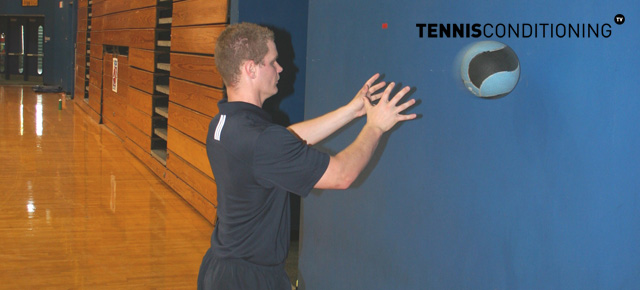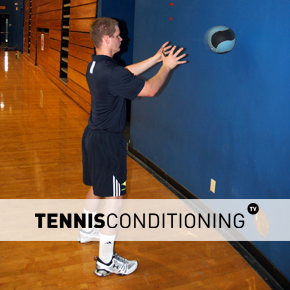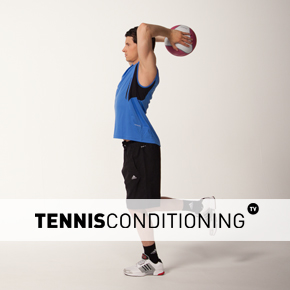The Medicine Ball Chest Pass is a plyometric exercise for beginners to develop neural pathways for explosive shots, body control and coordination.
The Medicine Ball Chest Pass may be implemented to improve power. The focus is on explosiveness, rather than the total amount of resistance you are going to use.
Therefore, we want to emphasize the speed of the action and control of the body.
Before you start implementing plyometric exercises into your training program you may want to learn more about tennis plyometric training and how to develop neural pathways for maximum power for better results.
Progressions
If you use additional weights…make sure you use appropriate weight so you can control the action throughout the entire range of motion. Otherwise you defeat the purpose of the exercise.
Very often, people use too much resistance and they become sloppy. Especially when it comes to maintaining core stability repetitively.
Also, don’t just progress with adding more weight. First, maximize the speed while maintaining perfect form.
Here are the progression levels:
- Beginner: athletic stance
- Advanced: lateral lunge position
- Professional: one leg stance
Medicine Ball Chest Pass Description

- Take on athletic stance with the feet hip to shoulder width apart.
- Open palms should firmly grasp the sides of the medicine ball six inches in front of the chest. A partner should stand around six feet away, or a wall can be used for a rebound.
- Forcefully extend the arms forward to propel the medicine ball to the partner or wall.
- As the ball is returned, absorb the ball and re-release it as rapidly as possible. The arms do not have to fully extend in the pass as the idea is to perform rapid reps with minimal contact time with the ball.
Medicine Ball Chest Pass Targeted Musculature
- Pectoralis Major
- Serratus Anterior
Common Errors
- Failing to minimize contact time with the medicine ball
Related Plyometric Exercises
- Single Leg High Level Tuck Jump
- Low-Level Single Leg Lateral Box Jump Rebounds
- Medicine Ball Overhead Pass
Training Zone
We provide you with some more workouts and training tips you may be interested in to optimize your training.
Also, make sure that you warm up properly before and stretch out after your training session.




